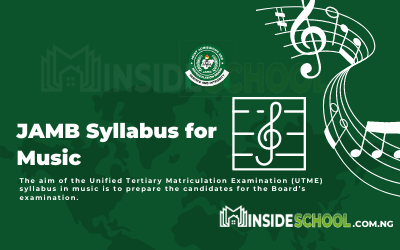JAMB Syllabus for Music [PDF] is out- The Music Syllabus from JAMB is an official document that contains detailed information and guides on the topics you are expected to cover in Music for your UTME. The aim of the Unified Tertiary Matriculation Examination (UTME) syllabus in Music is to prepare the candidates for the Board’s examination.

JAMB Syllabus for Music
GENERAL OBJECTIVES
The aim of the Unified Tertiary Matriculation Examination (UTME) syllabus in Music is to prepare the candidates for the Board’s examination. It is designed to test their achievement of the course objectives, which are to:
- Appreciate and discuss music fairly and critically;
- Identify, through written/aural analysis, the features of the music of different periods of western and African music theory history, peoples, its forms and the media;
- Appreciate the influence of socio-cultural and technological factors on the lives and music of musicians.
- Attain a sound musical basis for further learning at the tertiary level.
Recommended Links:
- How to Create a JAMB Online Profile
- JAMB Brochure
- Free JAMB Past Questions Available Here
- JAMB UTME Registration – Instructions & Guidelines
JAMB syllabus for Music 2021 PDF
You can CLICK BUTTON to download the syllabus in pdf or continue reading it on this website.
RECOMMENDED TEXTS
- Akpabot, S. E. (1986). Foundation of Nigerian Traditional Music, Ibadan: Spectrum.
- Associated Board of the Royal School of Music (1958). Rudiments and Theory of Music, London.
- Cole, W. (1969). The Form of Music, London: The Associated Board of the Royal Schools of Music. Echezona, W. W. C. (1981). Nigerian Musical Instruments, Enugu: Apollo Publishing Ltd.
- Ekwueme, L. (1993). Choir Training and Choral Conducting for Africans, Lagos: Lenaus Advertising and Publishing Company.
- Holst, I. (1963). An ABC of Music, Oxford: Oxford University Press.
- Hosier, (1961). Instruments of the Orchestra Oxford: Oxford University Press. Hunt, R. (1960). Elements of Music.
- Inanga, A. (1993). Music for Secondary Schools Vols. I and II, Ibadan: Spectrum.
- Kamien, R. (1990). Music: An Appreciation, London: McGraw – Hill Publishing Company.
- Kennedy, M. (1985). The Concise Oxford Dictionary of Music, (Third Edition), London: Oxford University Press. Kitson, C. H. (1978). Elementary Harmony Book 2, London: Oxford University Press.
- Kofoworola, Z. O. And Lateef, Y. (1987). Hausa performing Arts and Music, Lagos: Nigeria Magazine. Lovelock, W. (1953). A Concise History of Music, London: Bell and Hyman.
- Lovelock, W.(1996). The Rudiments of Music, London. G. Bell and sons Limited. Machlis, J. (1977). The Enjoyment of Music, New York: W. W. Norton.
- Mensah, A. A. (Undated) Folksongs for Schools, Accra.
- Morris, R. O. (1974). The Oxford Harmony, Vol. I, London: Oxford University Press. Nketia, J. H. (1974). African Music, New York: W. W. Norton Company.
- Palmer, K. (1965). Teach Yourself Music, London: The English University Press Limited. Reed, H. O. (1954). Basic Music: A Basic Theory Text, New York:, N. Y. Mills Music Inc. Taylor, E. (1989). The Guide to Music Theory, London: The Associated Board of The Royal School of Music. Warburton, A. O. (1955). Graded Music Course for Schools, Books I – III, London: Longman



